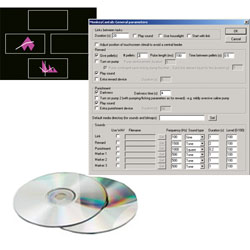
A complete set of CANTAB applications plus WhiskerServer™. Sold as one license copy per Intellistation.
This package includes the CANTAB test applications and the basic Whisker Multimedia Suite necessary to run those applications. It does not allow you to write original programs in any of the many languages supported by Whisker. For this ability, please contact Lafayette Instrument Company.
The Monkey CANTAB application portfolio comprises a battery of tests performed via a touch screen. Batteries are flexible and can be configured by the user. Multiple tests may be linked in the same subject session. Systems may be provided with pellet reward (recommended for the Rhesus monkey) liquid reward (recommended for the Marmoset) or both.
The aim of this program is to teach the monkeys that the onset of a tone signals the availability of reinforcement. This is the standard signal for the availability of reinforcement across all the cognitive tests.
Features
The aim of this program is to train the monkey to touch a solid box that is presented anywhere on the computer touch screen.
Features
This set of visual discrimination and reversal tests can be used to study a range of cognitive processes including:
The two types of test that make up this program use either simple (one-dimensional) or compound (two-dimensional) stimuli. The dimensions used are color-filled shapes and white lines. Simple stimuli are composed of just one of these dimensions, whereas compound stimuli are composed of both. The stimuli are the same as those used for the human test.
This program tests the short-term memory using a non-repeating sequence of arbitrary symbols, analogous to the use of junk objects in the WGTA. The symbols used are the same as those used for the human CANTAB Delayed Match to Sample Test.
This program provides a test of working memory analogous to that tested in rodents with an 8-arm maze. A number of boxes appear on the screen with no obvious pattern. The subject must select each box in turn without revisiting a box once it has been touched. A number of options are available for training the subjects and for varying the difficulty of the task:
This task is analogous to Leonard's Five-Choice Serial Reaction Time task, which is based on the Continuous Performance test of Rosvold and Mirsky. The subject is presented with a tone (optional) and a set of empty target stimuli (typically five open circles) to signify the start of a trial, whereupon it makes an observing response by pressing a key or a screen stimulus. After a delay a target stimulus is presented for a specified duration in one of five places (e.g. a filled circle appears within one of the five open circles). If the subject touches the filled circle or the place where it was presented, it is reinforced: incorrect responses are punished. The accuracy of the response and the reaction time are recorded.
Features
This is a conditional learning and memory task in which the location of trial-unique patterns must be learned and remembered.
Features
This program provides conventional operant schedules of responding to a single fixed square at the center of the screen or on the response lever.
Features
A comprehensive listing of publications and studies that involve the Whisker systems. Compiled by the creaters of Whisker.